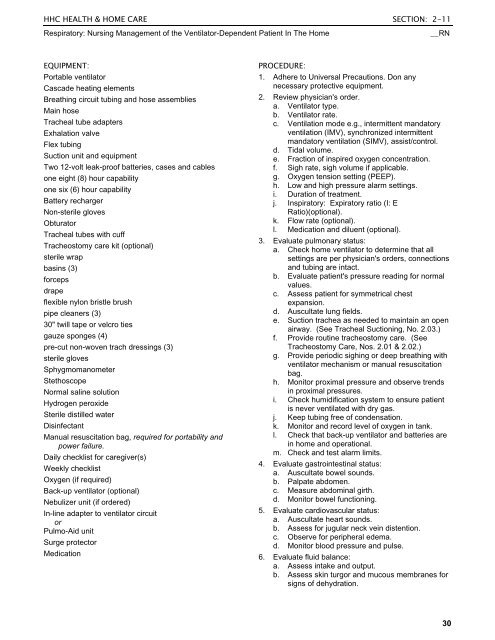HHC Health & Home Care Clinical Policy And
HHC Health & Home Care Clinical Policy And
HHC Health & Home Care Clinical Policy And
You also want an ePaper? Increase the reach of your titles
YUMPU automatically turns print PDFs into web optimized ePapers that Google loves.
<strong>HHC</strong> HEALTH & HOME CARE SECTION: 2-11<br />
Respiratory: Nursing Management of the Ventilator-Dependent Patient In The <strong>Home</strong> __RN<br />
EQUIPMENT:<br />
Portable ventilator<br />
Cascade heating elements<br />
Breathing circuit tubing and hose assemblies<br />
Main hose<br />
Tracheal tube adapters<br />
Exhalation valve<br />
Flex tubing<br />
Suction unit and equipment<br />
Two 12-volt leak-proof batteries, cases and cables<br />
one eight (8) hour capability<br />
one six (6) hour capability<br />
Battery recharger<br />
Non-sterile gloves<br />
Obturator<br />
Tracheal tubes with cuff<br />
Tracheostomy care kit (optional)<br />
sterile wrap<br />
basins (3)<br />
forceps<br />
drape<br />
flexible nylon bristle brush<br />
pipe cleaners (3)<br />
30" twill tape or velcro ties<br />
gauze sponges (4)<br />
pre-cut non-woven trach dressings (3)<br />
sterile gloves<br />
Sphygmomanometer<br />
Stethoscope<br />
Normal saline solution<br />
Hydrogen peroxide<br />
Sterile distilled water<br />
Disinfectant<br />
Manual resuscitation bag, required for portability and<br />
power failure.<br />
Daily checklist for caregiver(s)<br />
Weekly checklist<br />
Oxygen (if required)<br />
Back-up ventilator (optional)<br />
Nebulizer unit (if ordered)<br />
In-line adapter to ventilator circuit<br />
or<br />
Pulmo-Aid unit<br />
Surge protector<br />
Medication<br />
PROCEDURE:<br />
1. Adhere to Universal Precautions. Don any<br />
necessary protective equipment.<br />
2. Review physician's order.<br />
a. Ventilator type.<br />
b. Ventilator rate.<br />
c. Ventilation mode e.g., intermittent mandatory<br />
ventilation (IMV), synchronized intermittent<br />
mandatory ventilation (SIMV), assist/control.<br />
d. Tidal volume.<br />
e. Fraction of inspired oxygen concentration.<br />
f. Sigh rate, sigh volume if applicable.<br />
g. Oxygen tension setting (PEEP).<br />
h. Low and high pressure alarm settings.<br />
i. Duration of treatment.<br />
j. Inspiratory: Expiratory ratio (I: E<br />
Ratio)(optional).<br />
k. Flow rate (optional).<br />
l. Medication and diluent (optional).<br />
3. Evaluate pulmonary status:<br />
a. Check home ventilator to determine that all<br />
settings are per physician's orders, connections<br />
and tubing are intact.<br />
b. Evaluate patient's pressure reading for normal<br />
values.<br />
c. Assess patient for symmetrical chest<br />
expansion.<br />
d. Auscultate lung fields.<br />
e. Suction trachea as needed to maintain an open<br />
airway. (See Tracheal Suctioning, No. 2.03.)<br />
f. Provide routine tracheostomy care. (See<br />
Tracheostomy <strong>Care</strong>, Nos. 2.01 & 2.02.)<br />
g. Provide periodic sighing or deep breathing with<br />
ventilator mechanism or manual resuscitation<br />
bag.<br />
h. Monitor proximal pressure and observe trends<br />
in proximal pressures.<br />
i. Check humidification system to ensure patient<br />
is never ventilated with dry gas.<br />
j. Keep tubing free of condensation.<br />
k. Monitor and record level of oxygen in tank.<br />
l. Check that back-up ventilator and batteries are<br />
in home and operational.<br />
m. Check and test alarm limits.<br />
4. Evaluate gastrointestinal status:<br />
a. Auscultate bowel sounds.<br />
b. Palpate abdomen.<br />
c. Measure abdominal girth.<br />
d. Monitor bowel functioning.<br />
5. Evaluate cardiovascular status:<br />
a. Auscultate heart sounds.<br />
b. Assess for jugular neck vein distention.<br />
c. Observe for peripheral edema.<br />
d. Monitor blood pressure and pulse.<br />
6. Evaluate fluid balance:<br />
a. Assess intake and output.<br />
b. Assess skin turgor and mucous membranes for<br />
signs of dehydration.<br />
30







